Fan Lai
DiSCo: Device-Server Collaborative LLM-Based Text Streaming Services
Feb 17, 2025Abstract:The rapid rise of large language models (LLMs) in text streaming services has introduced significant cost and Quality of Experience (QoE) challenges in serving millions of daily requests, especially in meeting Time-To-First-Token (TTFT) and Time-Between-Token (TBT) requirements for real-time interactions. Our real-world measurements show that both server-based and on-device deployments struggle to meet diverse QoE demands: server deployments face high costs and last-hop issues (e.g., Internet latency and dynamics), while on-device LLM inference is constrained by resources. We introduce DiSCo, a device-server cooperative scheduler designed to optimize users' QoE by adaptively routing requests and migrating response generation between endpoints while maintaining cost constraints. DiSCo employs cost-aware scheduling, leveraging the predictable speed of on-device LLM inference with the flexible capacity of server-based inference to dispatch requests on the fly, while introducing a token-level migration mechanism to ensure consistent token delivery during migration. Evaluations on real-world workloads -- including commercial services like OpenAI GPT and DeepSeek, and open-source deployments such as LLaMA3 -- show that DiSCo can improve users' QoE by reducing tail TTFT (11-52\%) and mean TTFT (6-78\%) across different model-device configurations, while dramatically reducing serving costs by up to 84\% through its migration mechanism while maintaining comparable QoE levels.
Andes: Defining and Enhancing Quality-of-Experience in LLM-Based Text Streaming Services
Apr 25, 2024



Abstract:The advent of large language models (LLMs) has transformed text-based services, enabling capabilities ranging from real-time translation to AI-driven chatbots. However, existing serving systems primarily focus on optimizing server-side aggregate metrics like token generation throughput, ignoring individual user experience with streamed text. As a result, under high and/or bursty load, a significant number of users can receive unfavorable service quality or poor Quality-of-Experience (QoE). In this paper, we first formally define QoE of text streaming services, where text is delivered incrementally and interactively to users, by considering the end-to-end token delivery process throughout the entire interaction with the user. Thereafter, we propose Andes, a QoE-aware serving system that enhances user experience for LLM-enabled text streaming services. At its core, Andes strategically allocates contended GPU resources among multiple requests over time to optimize their QoE. Our evaluations demonstrate that, compared to the state-of-the-art LLM serving systems like vLLM, Andes improves the average QoE by up to 3.2$\times$ under high request rate, or alternatively, it attains up to 1.6$\times$ higher request rate while preserving high QoE.
FedTrans: Efficient Federated Learning via Multi-Model Transformation
Apr 25, 2024Abstract:Federated learning (FL) aims to train machine learning (ML) models across potentially millions of edge client devices. Yet, training and customizing models for FL clients is notoriously challenging due to the heterogeneity of client data, device capabilities, and the massive scale of clients, making individualized model exploration prohibitively expensive. State-of-the-art FL solutions personalize a globally trained model or concurrently train multiple models, but they often incur suboptimal model accuracy and huge training costs. In this paper, we introduce FedTrans, a multi-model FL training framework that automatically produces and trains high-accuracy, hardware-compatible models for individual clients at scale. FedTrans begins with a basic global model, identifies accuracy bottlenecks in model architectures during training, and then employs model transformation to derive new models for heterogeneous clients on the fly. It judiciously assigns models to individual clients while performing soft aggregation on multi-model updates to minimize total training costs. Our evaluations using realistic settings show that FedTrans improves individual client model accuracy by 14% - 72% while slashing training costs by 1.6X - 20X over state-of-the-art solutions.
Learn To be Efficient: Build Structured Sparsity in Large Language Models
Feb 13, 2024



Abstract:Large Language Models (LLMs) have achieved remarkable success with their billion-level parameters, yet they incur high inference overheads. The emergence of activation sparsity in LLMs provides a natural approach to reduce this cost by involving only parts of the parameters for inference. Existing methods only focus on utilizing this naturally formed activation sparsity, overlooking the potential for further amplifying this inherent sparsity. In this paper, we hypothesize that LLMs can learn to be efficient by achieving more structured activation sparsity. To achieve this, we introduce a novel algorithm, Learn-To-be-Efficient (LTE), designed to train efficiency-aware LLMs to learn to activate fewer neurons and achieve a better trade-off between sparsity and performance. Furthermore, unlike SOTA MoEfication methods, which mainly focus on ReLU-based models, LTE can also be applied to LLMs like GPT and LLaMA with soft activation functions. We evaluate LTE on four models and eleven datasets. The experiments show that LTE achieves a better trade-off between sparsity and task performance. For instance, LTE with LLaMA provides a 1.83x-2.59x FLOPs speed-up on language generation tasks, outperforming the state-of-the-art methods.
Fine-Grained Embedding Dimension Optimization During Training for Recommender Systems
Jan 09, 2024



Abstract:Huge embedding tables in modern Deep Learning Recommender Models (DLRM) require prohibitively large memory during training and inference. Aiming to reduce the memory footprint of training, this paper proposes FIne-grained In-Training Embedding Dimension optimization (FIITED). Given the observation that embedding vectors are not equally important, FIITED adjusts the dimension of each individual embedding vector continuously during training, assigning longer dimensions to more important embeddings while adapting to dynamic changes in data. A novel embedding storage system based on virtually-hashed physically-indexed hash tables is designed to efficiently implement the embedding dimension adjustment and effectively enable memory saving. Experiments on two industry models show that FIITED is able to reduce the size of embeddings by more than 65% while maintaining the trained model's quality, saving significantly more memory than a state-of-the-art in-training embedding pruning method. On public click-through rate prediction datasets, FIITED is able to prune up to 93.75%-99.75% embeddings without significant accuracy loss.
Venn: Resource Management Across Federated Learning Jobs
Dec 13, 2023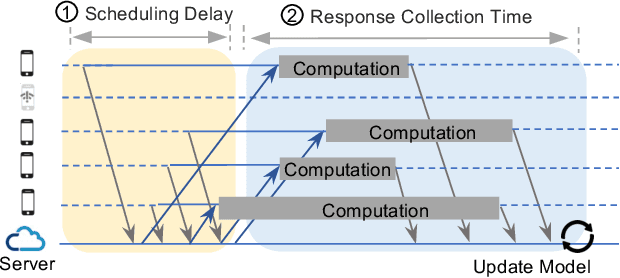
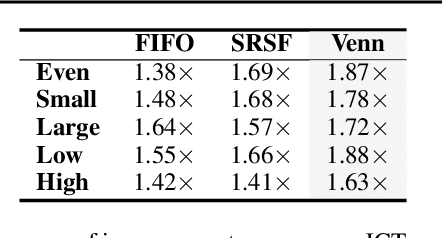
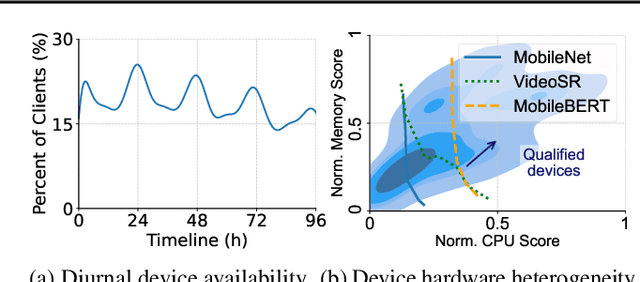
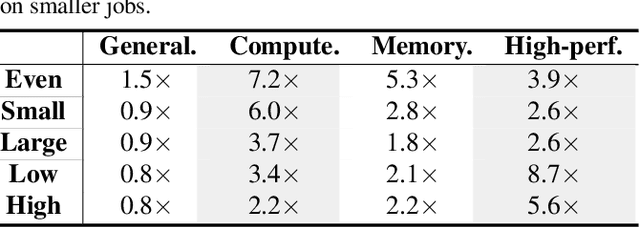
Abstract:In recent years, federated learning (FL) has emerged as a promising approach for machine learning (ML) and data science across distributed edge devices. With the increasing popularity of FL, resource contention between multiple FL jobs training on the same device population is increasing as well. Scheduling edge resources among multiple FL jobs is different from GPU scheduling for cloud ML because of the ephemeral nature and planetary scale of participating devices as well as the overlapping resource requirements of diverse FL jobs. Existing resource managers for FL jobs opt for random assignment of devices to FL jobs for simplicity and scalability, which leads to poor performance. In this paper, we present Venn, an FL resource manager, that efficiently schedules ephemeral, heterogeneous devices among many FL jobs, with the goal of reducing their average job completion time (JCT). Venn formulates the Intersection Resource Scheduling (IRS) problem to identify complex resource contention among multiple FL jobs. Then, Venn proposes a contention-aware scheduling heuristic to minimize the average scheduling delay. Furthermore, it proposes a resource-aware device-to-job matching heuristic that focuses on optimizing response collection time by mitigating stragglers. Our evaluation shows that, compared to the state-of-the-art FL resource managers, Venn improves the average JCT by up to 1.88X.
Auxo: Heterogeneity-Mitigating Federated Learning via Scalable Client Clustering
Oct 29, 2022Abstract:Federated learning (FL) is an emerging machine learning (ML) paradigm that enables heterogeneous edge devices to collaboratively train ML models without revealing their raw data to a logically centralized server. Heterogeneity across participants is a fundamental challenge in FL, both in terms of non-independent and identically distributed (Non-IID) data distributions and variations in device capabilities. Many existing works present point solutions to address issues like slow convergence, low final accuracy, and bias in FL, all stemming from the client heterogeneity. We observe that, in a large population, there exist groups of clients with statistically similar data distributions (cohorts). In this paper, we propose Auxo to gradually identify cohorts among large-scale, low-participation, and resource-constrained FL populations. Auxo then adaptively determines how to train cohort-specific models in order to achieve better model performance and ensure resource efficiency. By identifying cohorts with smaller heterogeneity and performing efficient cohort-based training, our extensive evaluations show that Auxo substantially boosts the state-of-the-art solutions in terms of final accuracy, convergence time, and model bias.
Coverage-centric Coreset Selection for High Pruning Rates
Oct 28, 2022Abstract:One-shot coreset selection aims to select a subset of the training data, given a pruning rate, that can achieve high accuracy for models that are subsequently trained only with that subset. State-of-the-art coreset selection methods typically assign an importance score to each example and select the most important examples to form a coreset. These methods perform well at low pruning rates; but at high pruning rates, they have been found to suffer a catastrophic accuracy drop, performing worse than even random coreset selection. In this paper, we explore the reasons for this accuracy drop both theoretically and empirically. We extend previous theoretical results on the bound for model loss in terms of coverage provided by the coreset. Inspired by theoretical results, we propose a novel coverage-based metric and, based on the metric, find that coresets selected by importance-based coreset methods at high pruning rates can be expected to perform poorly compared to random coresets because of worse data coverage. We then propose a new coreset selection method, Coverage-centric Coreset Selection (CCS), where we jointly consider overall data coverage based on the proposed metric as well as importance of each example. We evaluate CCS on four datasets and show that they achieve significantly better accuracy than state-of-the-art coreset selection methods as well as random sampling under high pruning rates, and comparable performance at low pruning rates. For example, CCS achieves 7.04% better accuracy than random sampling and at least 20.16% better than popular importance-based selection methods on CIFAR10 with a 90% pruning rate.
Swan: A Neural Engine for Efficient DNN Training on Smartphone SoCs
Jun 09, 2022



Abstract:The need to train DNN models on end-user devices (e.g., smartphones) is increasing with the need to improve data privacy and reduce communication overheads. Unlike datacenter servers with powerful CPUs and GPUs, modern smartphones consist of a diverse collection of specialized cores following a system-on-a-chip (SoC) architecture that together perform a variety of tasks. We observe that training DNNs on a smartphone SoC without carefully considering its resource constraints can not only lead to suboptimal training performance but significantly affect user experience as well. In this paper, we present Swan, a neural engine to optimize DNN training on smartphone SoCs without hurting user experience. Extensive large-scale evaluations show that Swan can improve performance by 1.2 - 23.3x over the state-of-the-art.
Efficient DNN Training with Knowledge-Guided Layer Freezing
Jan 17, 2022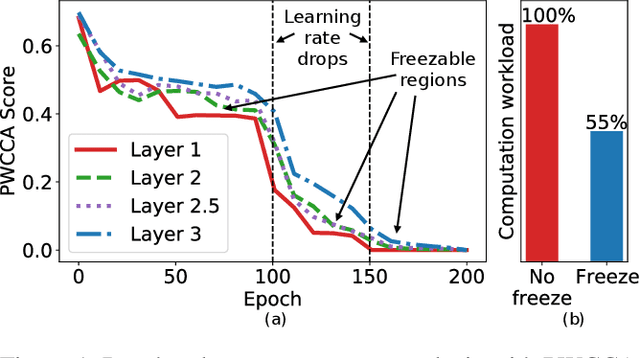
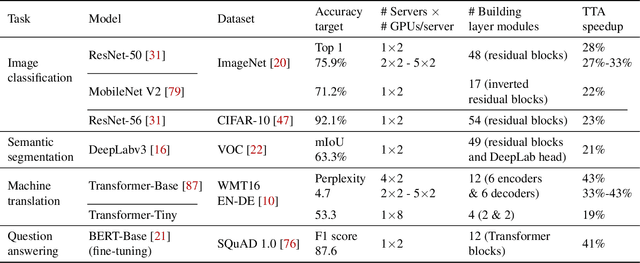
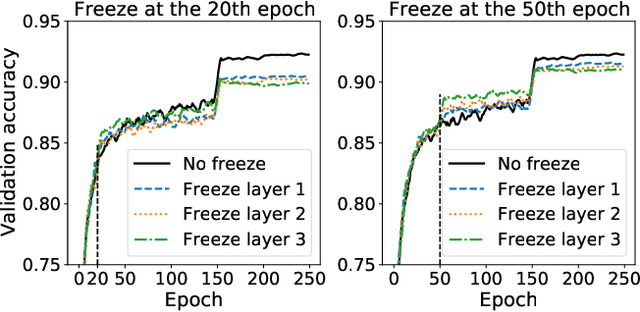

Abstract:Training deep neural networks (DNNs) is time-consuming. While most existing solutions try to overlap/schedule computation and communication for efficient training, this paper goes one step further by skipping computing and communication through DNN layer freezing. Our key insight is that the training progress of internal DNN layers differs significantly, and front layers often become well-trained much earlier than deep layers. To explore this, we first introduce the notion of training plasticity to quantify the training progress of internal DNN layers. Then we design KGT, a knowledge-guided DNN training system that employs semantic knowledge from a reference model to accurately evaluate individual layers' training plasticity and safely freeze the converged ones, saving their corresponding backward computation and communication. Our reference model is generated on the fly using quantization techniques and runs forward operations asynchronously on available CPUs to minimize the overhead. In addition, KGT caches the intermediate outputs of the frozen layers with prefetching to further skip the forward computation. Our implementation and testbed experiments with popular vision and language models show that KGT achieves 19%-43% training speedup w.r.t. the state-of-the-art without sacrificing accuracy.
 Add to Chrome
Add to Chrome Add to Firefox
Add to Firefox Add to Edge
Add to Edge